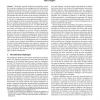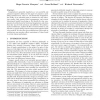AISC
2008
Springer
14 years 1 months ago
2008
Springer
Abstract. We introduce and study a tactic language, Hitac, for constructing hierarchical proofs, known as hiproofs. The idea of hiproofs is to superimpose a labelled hierarchical n...
AISC
2008
Springer
14 years 1 months ago
2008
Springer
A child, or young human-like robot of the future, needs to develop an information-processing architecture, forms of representation, and mechanisms to support perceiving, manipulati...
AISC
2008
Springer
14 years 1 months ago
2008
Springer
Abstract. McDermott [12,13] introduced the concept "Artificial Intelligence meets Natural Stupidity". In this paper, we explore how Artificial Intelligence and Symbolic C...
AISC
2008
Springer
14 years 1 months ago
2008
Springer
AISB
2008
Springer
14 years 1 months ago
2008
Springer
According to the traditional conception of the mind, semantical content is perhaps the most important feature distinguishing mental from non-mental systems. And this traditional co...
AISB
2008
Springer
14 years 1 months ago
2008
Springer
Abstract. A fundamental and unanalysed logical concept is substitution. This seemingly innocuous operation -- substituting a variable for a term or valuating a variable to an eleme...
AISB
2008
Springer
14 years 1 months ago
2008
Springer
Like computers before them, social robots can be used as a fundamental research tool. Indeed, they can help us to turn our attention from putative inner modules to thinking about t...
AISB
2008
Springer
14 years 1 months ago
2008
Springer
Philosophy, artificial intelligence and cognitive science have long been dominated by the presupposition that intelligence is fundamentally individual. Recent work in cognitive sci...
AISB
2008
Springer
14 years 1 months ago
2008
Springer
Imagination is generally regarded as a very powerful and advanced cognitive ability. In this paper we propose a modelling framework for what we call functional imagination: the ab...
AISB
2008
Springer
14 years 1 months ago
2008
Springer
This position paper argues the case for the application of constructivist theories to Artificial Intelligence, with particular emphasis on Piaget's theory. The idea of buildin...


